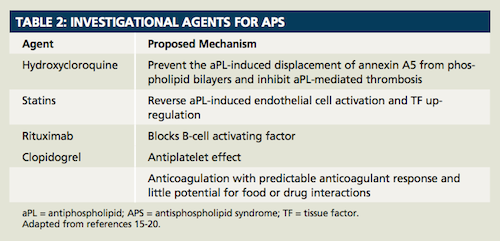Publication
Article
Pharmacy Times
Antiphospholipid Syndrome: Using Anticoagulants Properly
Author(s):
Current treatment addresses the damage caused by thromboembolic events.
Current treatment addresses the damage caused by thromboembolicevents.
The autoimmune disorder antiphospholipid syndrome (APS) earns its name from its laboratory profile, but in a complicated way: over time, we’ve learned that antiphospholipid (aPL) antibodies are not the best or only markers for this syndrome. When APS was first described in the 1980s, researchers linked aPL antibodies to APS, but struggled to determine whether they were causal or coincidental to another problem. Among healthy Americans who do not have APS, 1% to 5% have elevated aPL antibodies. This means elevated aPL alone is not diagnostic—that is, aPL can be elevated with no clinical repercussions.
Further, among systemic lupus erythematosus (SLE) patients, 30% to 40% of patients have aPL antibodies, but only approximately 10% have APS. In patients with APS, researchers later found that antibodies directed against membrane anionic phospholipids—anticardiolipin [aCL] antibody, lupus anticoagulant (aL), or associated plasma proteins (usually beta-2 glycoprotein 1)—are persistently elevated. But, the presence of aCL antibodies increases with age, often with no clinical repercussions.1 A true APS diagnosis requires aberrant lab work on 2 occasions more than 12 weeks apart plus 1 or more episodes of vascular thrombosis or obstetrical complication.2
What Is APS?
APS alters the homeostatic regulation of blood coagulation, and researchers have yet to determine why. Its hallmark signs are recurrent venous or arterial thrombosis and/or fetal miscarriage. Approximately half of patients simply develop APS alone, with the rest developing APS secondary to SLE or another rheumatic or autoimmune disorder. Today’s preferred jargon is APS with or without associated rheumatic disease,3 discarding the older “primary” and “secondary” terms to avoid implying that one condition is different from or subordinate to the other.
APS’s clinical manifestations can be widespread, as hypercoagulability and recurrent thrombosis have the potential to affect multiple organs. Most often APS patients develop deep venous thrombosis (DVT) and pulmonary embolism. APS patients may also develop other serious health consequences (Table 1).

Patients who suffer ischemic stroke at an inordinately young age should be tested for APS, as stroke is likely to occur without adequate prophylaxis.1,4
Obstetric patients with APS may deliver preterm or develop eclampsia. Spontaneous abortion may be due to thrombosis in the placental bed, recurrent early fetal loss (before 10 weeks’ gestation), or fetal loss in the second or third trimesters. Clinicians should screen women who have had more than 3 miscarriages before 10 weeks’ gestation for APS. Pregnancy itself can interfere with aPL testing; ideally, clinicians should test when the woman is not pregnant.1
Rarely, patients may present with catastrophic APS (CAPS), which is characterized by multiorgan infarctions over a period of days to weeks. Approximately one-third of patients with CAPS die.5
Planning Treatment: Dose and Duration
Clinicians must immediately follow an APS diagnosis with individualized treatment planning based on the patient’s unique clinical status and thrombotic event history. Most interventions are similar to those used for patients who have non-APS variants of hypercoagulability. The clinical conundrums are, too. Most experts still debate whether high-dose, aggressive drug treatment is better than low-dose treatment. Studies using traditional treatments—anticoagulants and steroids—are under way now to find answers. Treatment duration is also largely empiric.
Prevention is key, and patients must avoid oral contraceptives and quit smoking. Treating hypertension or hyperlipidemia is important, as these are risk factors for clotting. Although clinicians often prescribe low-dose aspirin as prophylaxis, like most other treatments, its effectiveness is under review.
All treatment should commence with a frank discussion of APS’s risks and benefits, and the need for adherence and monitoring, if these are necessary. If an acute thrombotic event occurs, patients will need full anticoagulation with intravenous or subcutaneous heparin followed by warfarin therapy. When warfarin is used, clinicians aim for an international normalized ratio (INR) of 2.0 to 3.0 for venous thrombosis and 3.0 for arterial thrombosis. If thrombotic events recur or are significant, the patient may need lifelong prophylaxis.1,3,6 Corticosteroids are not needed for patients with uncomplicated APS.
Complicated APS
Patients who experience recurrent DVT will definitely need lifelong anticoagulation and may need surgery to place an inferior vena cava filter.
Treatment of the pregnant APS patient is controversial, because so many clinicians and pregnant patients prefer to avoid all medication during pregnancy. The American College of Obstetricians and Gynecologists guidelines recommend prophylaxis for pregnant women with no history of thrombosis and full anticoagulation for those with a history of thrombosis.7,8
Low-dose aspirin may be sufficient to prevent miscarriage in women with uncomplicated histories.9 Warfarin is contraindicated in pregnancy, although it can be taken during breast-feeding. Women who have had previous APS-related pregnancy losses should receive prophylactic subcutaneous heparin (preferably low—molecular-weight heparin) and low-dose aspirin. Around the time of delivery, all medications should be discontinued, then restarted after delivery and continued for 6 to 12 weeks postpartum. Women who have had previous thrombosis should receive therapeutic heparin doses throughout gestation and long term anticoagulation postpartum. Corticosteroids may increase maternal morbidity and fetal prematurity rates. Administering heparin or corticosteroids long-term may cause osteoporosis, so the guidelines recommend calcium and vitamin D supplements.6,9,10
Patients who have comorbid SLE present challenges, especially if they have active or end-stage disease. Lupus anticoagulants may react with reagents used to perform the INR, complicating monitoring.11 SLE patients who have a positive aPL may respond to hydroxychloroquine’s antithrombotic properties as prophylaxis.
Patients who develop CAPS need intensive hospital-based care. Aggressive anticoagulation, plasma exchange, and corticosteroids are standard interventions, but no controlled trials demonstrate clear benefit. Intravenous immunoglobulin may be of some benefit and cyclophosphamide is sometimes administered, especially in SLE-associated CAPS.10 Rituximab has shown promise in the treatment of APS, and clinical trials are under way.12,13
Conclusion
Research continues to find better agents. Our current treatments address symptoms and damages caused by thromboembolic events.

APS is a “systemic” disease, and as we dismantle and understand the molecular mechanisms of aPL-mediated damage, we may find an immunomodulatory approach (Table 2).14
Until then, we must use traditional agents responsibly, and counsel patients to remain vigilant and aware of signs of developing clots.
Ms. Wick is a visiting professor at the University of Connecticut School of Pharmacy and a freelance clinical writer.
References:
- Keeling D, Mackie I, Moore GW, Greer IA, Greaves M. British Committee for Standards in Haematology. Guidelines on the investigation and management of antiphospholipid syndrome. Br J Haematol. 2012;157:47-58.
- Taraborelli M, Andreoli L, Tincani A. Much more than thrombosis and pregnancy loss: the antiphospholipid syndrome as a “systemic disease”. Best Pract Res Clin Rheumatol. 2012;26:79-90.
- Miyakis S, Lockshin MD, Atsumi T, et al. International consensus statement on an update of the classification criteria for definite antiphospholipid syndrome (APS). J Thromb Haemost. 2006;4:295-306.
- Mayer M, Cerovec M, Rados M, Cikes N. Antiphospholipid syndrome and central nervous system. Clin Neurol Neurosurgery. 2010;112:602-608.
- Espinosa G, Berman H, Cervera R. Management of refractory cases of catastrophic antiphospholipid syndrome. Autoimmun Rev. 2011;10:664-668.
- Mehta TP, Smythe MA, Mattson JC. Strategies for managing heparin therapy in patients with antiphospholipid antibody syndrome. Pharmacotherapy. 2011;31:1221-1231.
- American College of Obstetricians and Gynecologists. Antiphospholipid syndrome. National Guideline Clearinghouse. http://guideline.gov/summary/summary.aspx?doc_id=10928. Accessed October 25, 2012.
- Ernest JM, Marshburn PB, Kutteh WH. Obstetric antiphospholipid syndrome: an update on pathophysiology and management. Semin Reprod Med. 2011;29:522-539.
- Laskin CA, Spitzer KA, Clark CA, et al. Low molecular weight heparin and aspirin for recurrent pregnancy loss: results from the randomized, controlled HepASA Trial. J Rheumatol. 2009;36:279-287.
- Heilmann L, Schorch M, Hahn T, et al. Pregnancy outcome in women with antiphospholipid antibodies: report on a retrospective study. Semin Thromb Hemost. 2008;34:794-802.
- Tripodi A, Chantarangkul V, Clerici M, Negri B, Galli M, Mannucci PM. Laboratory control of oral anticoagulant treatment by the INR system in patients with the antiphospholipid syndrome and lupus anticoagulant: results of a collaborative study involving nine commercial thromboplastins. Br J Haematol. 2001;115:672-678.
- Ramos-Casals M, Brito-Zerón P, Muñoz S, Soto MJ. A systematic review of the off-label use of biological therapies in systemic autoimmune diseases. Medicine (Baltimore). 2008;87:345-364.
- Lockshin MD. Update on antiphospholipid syndrome. Bull NYU Hosp Jt Dis. 2008;66:195-197.
- Henriques CC, Lourenço F, Lopéz B, Panarra A, Riso N. Antiphospholipid syndrome and recurrent thrombosis--limitations of current treatment strategies. BMJ Case Rep. 2012;2012. pii: bcr1120115147.
- Lopez-Pedrera C, Ruiz-Limon P, Aguirre MA, Rodriguez-Ariza A, Cuadrado MJ. Potential use of statins in the treatment of antiphospholipid syndrome. Curr Rheumatol Rep. 2012;14:87-94.
- Ruiz-Irastorza G, Cuadrado MJ, Ruiz-Arruza I, et al. Evidence-based recommendations for the prevention and long-term management of thrombosis in antiphospholipid antibody-positive patients: report of a task force at the 13th International Congress on antiphospholipid antibodies. Lupus. 2011;20:206-218.
- Kumar D, Roubey RA. Use of rituximab in the antiphospholipid syndrome. Curr Rheumatol Rep. 2010;12:40-44.
- Rubenstein E, Arkfeld DG, Metyas S, Shinada S, Ehresmann S, Liebman HA. Rituximab treatment for resistant antiphospholipid syndrome. J Rheumatol. 2006;33:355-357.
- Giles I, Khamashta M, D’Cruz D, Cohen H. A new dawn of anticoagulation for patients with antiphospholipid syndrome? Lupus. 2012;21:1263-1265.
- Balaban M, Stanrić V, Rincić G, et al. Recurrent venous thrombosis despite ‘optimal anticoagulation therapy’ for antiphospholipid syndrome--could new oral anticoagulants solve the problem? Acta Clin Croat. 2010;49:469-377.







